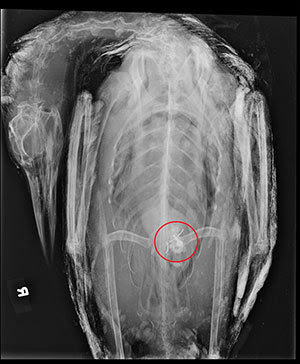
A radiograph reveals a lead tackle object in the gizzard of the deceased loon. Photo courtesy of Meadow Pond Animal Hospital.
MOULTONBOROUGH, N.H. – The first documented lead-poisoned loon collected from New Hampshire waters this year was discovered July 1, 2015, on Lake Winnipesaukee. The loon was collected in Loon Cove of Alton Bay, after it was found dead on the beach. Radiographs at Meadow Pond Animal Hospital showed a lead tackle object in the loon’s gizzard, so it was transported to UNH Diagnostic Veterinary Laboratory to be necropsied. Necropsy results found a lead jig and blood tests revealed toxic blood lead levels. July and August are when lead-poisoned loons are most often found. This correlates with peak lake use and fishing pressure in the state.
The link between loon deaths and lead poisoning first emerged in the 1980s, when the discovery was made that loons were ingesting lead fishing tackle in the form of sinkers and jigs. Necropsies performed by the Tufts University School of Veterinary Medicine on dead adult common loons in New Hampshire revealed that 48% had the remains of lead sinkers and jigs in their gizzards and had died from lead poisoning. A loon will die from lead poisoning approximately two to four weeks after ingesting lead tackle.
“It seems likely that loons are eating fish that have tackle in or on them. As the acidic juices in the bird’s gizzard break down the food, the lead is also broken down and gets into the bloodstream of the bird,” said Emily Preston, a wildlife biologist with the N.H. Fish and Game Department. “The good news is that using alternatives to lead tackle should provide immediate relief to the loon population.”
Necropsies of dead adult loons show that lead tackle accounts for more deaths than every other human factor combined. The loss of so many adults from this preventable cause of mortality has inhibited the recovery of loons in New Hampshire, according to the LPC. “Because loons do not breed until 6-7 years of age and have low reproductive success, it is important that adult loons survive for many years to produce surviving young,” said Harry Vogel, Senior Biologist and Executive Director at LPC. “The loss of an adult loon may also result in the loss of that loon’s nest or chicks, further negatively impacting the population.”
To address this problem, Fish and Game convened a statewide Lead and Loon Working Group in 2013 to provide a forum for diverse partners to work toward the common goal of motivating all anglers to change to lead-free tackle. This effort has now joined a region-wide initiative called Fish Lead-Free (www.fishleadfree.org), which is providing resources and information across New England.
The push is on to educate anglers because a new law goes into effect in New Hampshire on June 1, 2016, banning the sale and freshwater use of lead fishing sinkers and jigs (lead-weighted hooks) weighing one ounce or less.
The N.H. Fish and Game Department and The Loon Preservation Committee urge all anglers to remove lead tackle from their tackle boxes now to protect loons and other waterfowl. Safe alternatives to lead tackle, made of steel, tungsten, tin, bismuth and many other materials, are effective and readily available. Learn more tips and tactics for fishing lead-free at www.wildlife.state.nh.us/
“Lead is a known factor that we have the ability to address. It is something we can choose to change,” said Laura Ryder, Education Programs Supervisor at Fish and Game. With that in mind, the Fish Lead Free Initiative is reaching out to anglers from all walks of life and providing information to help them choose alternatives to lead fishing tackle.
Many New Hampshire anglers have already made the switch. “Switching to lead-alternative tackle is the right thing to do, not just for the recovery of our loons, but also for other aquatic wildlife that may be vulnerable to ingesting lead sinkers and jigs,” said Jason Smith, Chief of Inland Fisheries at the Fish and Game Department. “We always have choices, and this choice can help the common loon to make a more solid recovery.”
Source: News from the New Hampshire Fish and Game Department
